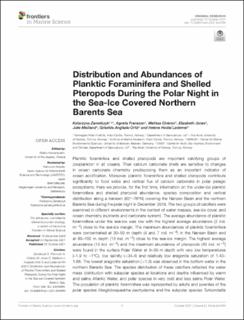| dc.contributor.author | Zamelczyk, Katarzyna | |
| dc.contributor.author | Fransson, Agneta | |
| dc.contributor.author | Chierici, Melissa | |
| dc.contributor.author | Jones, Elizabeth Marie | |
| dc.contributor.author | Meilland, Julie | |
| dc.contributor.author | Anglada-Ortiz, Griselda | |
| dc.contributor.author | Hodal Lødemel, Helene | |
| dc.date.accessioned | 2021-11-05T13:04:10Z | |
| dc.date.available | 2021-11-05T13:04:10Z | |
| dc.date.created | 2021-10-22T10:01:26Z | |
| dc.date.issued | 2021 | |
| dc.identifier.citation | Frontiers in Marine Science. 2021, 8 1-19. | |
| dc.identifier.issn | 2296-7745 | |
| dc.identifier.uri | https://hdl.handle.net/11250/2828179 | |
| dc.description.abstract | Planktic foraminfera and shelled pteropods are important calcifying groups of zooplankton in all oceans. Their calcium carbonate shells are sensitive to changes in ocean carbonate chemistry predisposing them as an important indicator of ocean acidification. Moreover, planktic foraminfera and shelled pteropods contribute significantly to food webs and vertical flux of calcium carbonate in polar pelagic ecosystems. Here we provide, for the first time, information on the under-ice planktic foraminifera and shelled pteropod abundance, species composition and vertical distribution along a transect (82°–76°N) covering the Nansen Basin and the northern Barents Sea during the polar night in December 2019. The two groups of calcifiers were examined in different environments in the context of water masses, sea ice cover, and ocean chemistry (nutrients and carbonate system). The average abundance of planktic foraminifera under the sea-ice was low with the highest average abundance (2 ind. m–3) close to the sea-ice margin. The maximum abundances of planktic foraminifera were concentrated at 20–50 m depth (4 and 7 ind. m–3) in the Nansen Basin and at 80–100 m depth (13 ind. m–3) close to the sea-ice margin. The highest average abundance (13 ind. m–3) and the maximum abundance of pteropods (40 ind. m–3) were found in the surface Polar Water at 0–20 m depth with very low temperatures (–1.9 to –1°C), low salinity (<34.4) and relatively low aragonite saturation of 1.43–1.68. The lowest aragonite saturation (<1.3) was observed in the bottom water in the northern Barents Sea. The species distribution of these calcifiers reflected the water mass distribution with subpolar species at locations and depths influenced by warm and saline Atlantic Water, and polar species in very cold and less saline Polar Water. The population of planktic foraminifera was represented by adults and juveniles of the polar species Neogloboquadrina pachyderma and the subpolar species Turborotalita quinqueloba. The dominating polar pteropod species Limacina helicina was represented by the juvenile and veliger stages. This winter study offers a unique contribution to our understanding of the inter-seasonal variability of planktic foraminfera and shelled pteropods abundance, distribution and population size structure in the Arctic Ocean. | |
| dc.language.iso | eng | |
| dc.title | Distribution and Abundances of Planktic Foraminifera and Shelled Pteropods During the Polar Night in the Sea-Ice Covered Northern Barents Sea | |
| dc.type | Peer reviewed | |
| dc.type | Journal article | |
| dc.description.version | publishedVersion | |
| dc.source.pagenumber | 1-19 | |
| dc.source.volume | 8 | |
| dc.source.journal | Frontiers in Marine Science | |
| dc.identifier.doi | 10.3389/fmars.2021.644094 | |
| dc.identifier.cristin | 1947774 | |
| dc.relation.project | Norges forskningsråd: 276730 | |
| cristin.ispublished | true | |
| cristin.fulltext | original | |
| cristin.qualitycode | 1 | |
